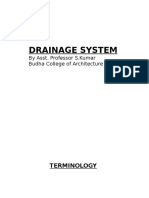Sanitary Pipework
Sanitary Pipework
Uploaded by
bocap811Copyright:
Available Formats
Sanitary Pipework
Sanitary Pipework
Uploaded by
bocap811Original Description:
Copyright
Available Formats
Share this document
Did you find this document useful?
Is this content inappropriate?
Copyright:
Available Formats
Sanitary Pipework
Sanitary Pipework
Uploaded by
bocap811Copyright:
Available Formats
Building Services Sanitary pipework
Waste Pipe Connections
Relevant British Standand BS 5572
When an appliance has been installed it will need to be connected to the above-ground
sanitary pipework. This is done by installing a waste fitting into the appliance and
connecting it to the discharge pipe via a trap. The different minimum sizes of waste
fitting and trap are given in the table.
Minimum appliance waste sizes
Type of appliance
Waste fitting
Discharge pipe
size (in)
and trap size (mm)
Sinks, showers, baths,
washing machines
and trough urinals
40
Wash basins, bidets,
drinking fountains and
bowl urinals
32
Stall and slab urinals
65
Appliances such as sinks and baths use a combination overflow and waste fitting. which
does away with the need for a separate overflow pipe discharging out of the building;
note that the overflow connects into the waste above the trap seal.
Appliances such as the Belfast butler sink, wash basins and bidets have an integral
(built in) overflow and therefore the waste fitting needs to have a slot to allow its
connection. The urinal bowl, on the other hand, has no overflow at all; thus an unslotted
waste fitting must be chosen. Most waste fittings connected to the appliance are best
fitted using a rubber-type material to give a good seal; however, materials such as
Plumbers' Mait (a non-setting putty) can be used, providing the appliance is completely
dry when it is applied.
Traps
A trap is a fitting or integral part of an appliance designed in such a way as to retain a
body of water, thus preventing the passage of foul air. There are many different
designs, including those with a vertical outlet (S traps), those with a near-horizontal
outlet (P traps), and those fitted in a pipe run, called running traps.
The depth of the trap seal would depend upon the circumstances and usage of the pipe,
but in general, pipes of less than 50 mm internal bore should have a trap with a seal of
not less than 75 mm however for baths and shower trays and for basins with spray
taps, provided that a flush-grated waste is fitted (i.e. no plug) this depth may be
reduced to 50 mm. If the appliance is discharging into an open gully, this depth may be
reduced to 38 mm. For pipes with a larger internal bore than 50 mm, a trap with a seal
of only 50 mm is required as trap seal loss is much less likely to occur in a pipe so large.
Traps up to 40 mm outlet size may be or either tubular or bottle trap design (see
figure). Tubular traps tend to be less prone to blockage. (See page 284 for an example
of a special trap which is designed to maintain its water seal under adverse design
conditions.)
/var/www/apps/conversion/tmp/scratch_2/320542165.doc
-1-
Building Services Sanitary pipework
/var/www/apps/conversion/tmp/scratch_2/320542165.doc
-2-
Building Services Sanitary pipework
Sanitary Pipework
Relevant British Stand BS 5572
A system of above-ground drainage designed to remove all the foul and waste water to the
below-ground drainage system. Originally, the foul water from soil appliances was kept
separate from the water from waste appliances and two separate discharge stacks were
required; the water only joined at ground level in the below-ground drainage system. This
type of system was known as the two-pipe system.
All sanitary pipework today is based on the one-pipe system in which one discharge stack is
used to convey both foul and waste waters. There are three basic systems in use, these
being the ventilated system, the ventilated stack system and the single stack system.
With the ventilated system a ventilating pipe is extended to connect to each of the
individual branch pipes throughout the system; it is designed to safeguard against trap seal
loss. This system is generally adopted in situations where it is no possible to have close
groupings of sanitary appliances, and long branch discharge pipes can be expected.
In the ventilated stack system only the main discharge stack is ventilated, to overcome
pressure fluctuations. With this system the branch discharge pipes connect directly into
the main stack without the need for a branch ventilating pipe. This system therefore, is only
suitable for buildings in which the sanitary appliances are closely grouped to the main stack.
Finally there is the single stack system, which is used in similar situations to the ventilated
stack system, the difference being that the stack ventilating pipe can be omitted if the
discharge stack is large enough to limit pressure fluctuations.
Whichever system is chosen, all work must comply with Part H of the Building Regulations.
Branch discharge pipe This pipe should connect to the main discharge stack in such a way
as not to cause any 'crossflow' into other pipes (see figure). The sizes of branch discharge
pipes should be at least the same diameter as the appliance trap. Oversizing the pipe to
avoid self-siphonage could prove uneconomical and lead to an increased rate of solid deposit
accumulation. Bends should be avoided but where they are unavoidable, long radius bends
should be used. The gradient of branch discharge pipes should be between 1 and 1 1/4 (1822 mm drop per metre run).
Branch ventilating pipe No branch ventilating pipe should connect to the discharge stack
below the spillover level of the highest fitting served. The minimum size for a branch
ventilating pipe serving a single appliance should be 25mm, but, where the branch run is
longer than 15m or contains more than five bends or serves more than one appliance, the
minimum pipe size should be 32mm.
/var/www/apps/conversion/tmp/scratch_2/320542165.doc
-3-
Building Services Sanitary pipework
/var/www/apps/conversion/tmp/scratch_2/320542165.doc
-4-
Building Services Sanitary pipework
Single Stack System
Relevant British Standard BS 5572
Most buildings are designed to meet the criteria of this system, therefore reducing
the cost of installation. The system is designed so that no separate ventilating pipes
are required to prevent trap seal loss. This can only be achieved by observing the
following guidelines:
(1) All sanitary appliances must be closely grouped to the discharge stack, within the
limits shown.
(2) All appliances, as far as possible, should be fitted with a P trap with a discharge
pipe diameter equal to that of the trap and bends in branch pipes avoided - the
gradient being kept to a minimum.
(3) The vertical discharge stack must be as straight as possible, with a long radius bend
fitted at its base.
(4) The lowest connection to the discharge stack must be a minimum of 450 mm above
the invert of the drain. If the building is over three storeys, this distance should be
increased to 750 mm and for buildings over five storeys, all groundfloor appliances
should not connect into the stack. In buildings over 20 storeys, all first floor, as well as
ground floor, appliances should not be connected.
(5) Where a range of appliances is installed, it should comply with the following table:
Unvented discharge pipes serving more than one appliance
Appliance
Max no. fitted
WC
Min pipe size
(mm)
100
Gradient
(mm/m)
9-90
Wash basin
50
18-90
Bowl urinal
50
18-90
Stall urinal
65
18-90
(6) The main discharge stack must be large enough to limit pressure fluctuations
without the need for a ventilating stack; as a general guide, 100 mm diameter is
required for buildings with up to five storeys and 150 mm diameter for those with up to
20 storeys, with two groups of appliances on each floor. (Note: a group of appliances
consists of one WC, bath, basin and sink.)
(7) Branch connections must join the main vertical discharge stack at an angle of 45 or
at a radius of 25 mm for pipes up to 75 mm in diameter and a radius of 50 mm for pipes
over 75 mm in diameter.
Where the discharge pipe exceeds the criteria listed, it should be vented by a branch
ventilating pipe, located at the highest point, extended to the atmosphere or connected
to a ventilating stack, in which case the system is generally referred to as a `modified
single stack system'. Sometimes air admittance valves, or resealing traps, are used
which allow air into the system in order to prevent trap seal loss.
/var/www/apps/conversion/tmp/scratch_2/320542165.doc
-5-
Building Services Sanitary pipework
/var/www/apps/conversion/tmp/scratch_2/320542165.doc
-6-
Building Services Sanitary pipework
Ventilation of Sanitary Pipework
Relevant British Standard BS 5572
It is essential that air is freely allowed to enter discharge and drainage pipes and thus
help maintain an equilibrium of pressure within the pipe and the outside atmosphere:
for example, should the pressure be greater outside the pipe than inside, the trap seals
of sanitary appliances and gullies would be lost. By allowing a current of fresh air to
flow through the whole system, any foul matter adhering to the insides of pipes would
soon dry and be washed away; ventilating the pipes also prevents any build-up of foul
(and possibly dangerous) gases. Air enters the drain at low level, via holes in inspection
covers, etc., and rises up through the stack by convection currents.
The termination of a ventilating pipe into the atmosphere should be at a position that
does not cause a nuisance or health hazard. It is recommended that if a ventilating pipe
is within 3 m of a window opening it should be carried up above the window to a minimum
height of 0.9 m. Ventilating pipes should be fitted with a domical cage or grating which
does not unduly restrict the free air flow and prevents the nesting of birds, etc. The
size of the ventilating pipe may be reduced in houses up to two storeys. but should be
at least 75 mm in diameter.
Discharge stacks may terminate within the building when fitted with an air admittance
valve. These valves are designed to allow fresh air to enter the ventilating pipe but
prevent odours and gases escaping. Air admittance valves should not be used on
discharge stacks connecting to drains which are subject to surcharging (filling with
water) or on a drain which has an intercepting trap fitted, as they may cause the trap
seal loss of the appliance.
The number of air admittance valves fitted to a drainage system should be limited to
prevent excessive back pressures and, where five or more domestic dwellings are
located in the same drainage run, a conventional open ventilating pipe will be required at
the head of the system. Should the number of dwellings exceed ten, conventional
venting will be required at mid-point and at the head of the system. Note that the valve
must be located above the floor level of the discharge stack; where valves are fitted in
roof voids, etc., they should be insulated, because any condensation forming within may
freeze and prevent their use.
Stub stacks
A discharge stack which is capped off with a rodding eye at its top end. Stub stacks
are only permitted to be installed where they connect to a ventilated discharge stack
or drain within 6 m from the base of the stack. However, this distance is increased to
12 m maximum where a group of appliances is fitted. If a stub stack is used, no branch
waste connections may be made into the stack higher than 2 m above the invert level of
the drain, and, in the case of a WC pan connection, this distance is reduced to 1.5 m
maximum.
/var/www/apps/conversion/tmp/scratch_2/320542165.doc
-7-
Building Services Sanitary pipework
/var/www/apps/conversion/tmp/scratch_2/320542165.doc
-8-
Building Services Sanitary pipework
Trap Seal Loss
Relevant British Standard BS 5572
If the trap seal is lost, objectionable smells will enter the building; therefore, the water
seal in the trap must be maintained under all circumstances. Trap seal loss can result from
various unforeseen circumstances, such as leakages or evaporation. In designing any sanitary
discharge system, special care will need to be taken to prevent pressure fluctuations
occurring within the pipework itself. Typical design faults include:
Waving out Caused by the effects of the wind passing over the top of the ventilation pipe, bringing about pressure fluctuations; thus wave movements in the trap
gradually wash over the outlet.
Compression This generally only occurs in high-rise buildings where the discharge of water down the main discharge stack compresses the air at the base of the
stack, thus pushing the water out of the trap back into the appliance. This problem can
usually be overcome by ensuring that a long radius bend is installed at the base of the
stack and that no connections are made within 450 mm of the invert level of the drain;
alternatively, a relief vent should be carried down to connect to the lowest part of the
discharge stack.
Induced siphonage Caused by the discharge of water from another sanitary
appliance connected to the same discharge pipe. As the water falls down the pipe and
passes the branch pipe, it draws air from within, thus creating a partial vacuum;
subsequently, siphonage of the trap takes place. To overcome this problem, trap
ventilating pipes could be introduced into the system; these would permit air into the
discharge pipe, preventing the development of a partial vacuum.
Self-siphonage Mostly caused in such appliances as wash basins; being funnel
shaped, they tend to discharge their contents of water quickly. As the water discharges
it sets up a plug of water, which, as it passes down the pipe creates a partial vacuum,
thus causing siphonic action to take place. To overcome this problem of self-siphonage, a
larger waste pipe is sometimes used, but in most cases a resealing trap cures the
problem.
Resealing traps
A trap designed to maintain its water seal should a partial vacuum be created in the waste
discharge pipe. There are various designs of resealing trap and the moss common one used
today incorporates an anti-vacuum valve; should the pressure drop inside the discharge pipe,
this valve opens under atmospheric pressure, giving a state of equilibrium inside the pipe.
Unfortunately these traps often tend to leak through this valve. The other types of
resealing trap work on the principle of retaining the water in a reserve chamber should the
conditions be right for siphonic action to take place.
Extracts from
Treloar R D - Plumbing Heating and Gas Installations 2nd Edition Blackwell Science, 2000
/var/www/apps/conversion/tmp/scratch_2/320542165.doc
-9-
Building Services Sanitary pipework
/var/www/apps/conversion/tmp/scratch_2/320542165.doc
- 10 -
You might also like
- CLSU ABE Review2021 Irrigation and Drainage EngineeringDocument197 pagesCLSU ABE Review2021 Irrigation and Drainage EngineeringJireh Loquinario100% (2)
- Drainagesystemslecturei 091022013358 Phpapp02Document62 pagesDrainagesystemslecturei 091022013358 Phpapp02Abdul Raoof100% (2)
- Final Report For PSFSDocument19 pagesFinal Report For PSFSBenny BennyNo ratings yet
- Ventilation: Plant RoomDocument3 pagesVentilation: Plant RoomggrapsasNo ratings yet
- Se Sovent Design Manual 101o New011007Document24 pagesSe Sovent Design Manual 101o New011007jomy_pj8106100% (1)
- ASPE PSD - Storm Drainage ComponentsDocument2 pagesASPE PSD - Storm Drainage ComponentsNiong DavidNo ratings yet
- Sizing Water Tanks With AnswersDocument9 pagesSizing Water Tanks With AnswersNicole Lumapas0% (1)
- Cold Water SupplyDocument18 pagesCold Water Supplyrenatosalazar21No ratings yet
- 13.8 Water Supply Systems DesignDocument2 pages13.8 Water Supply Systems DesignAngelyn MarantalNo ratings yet
- 01-2021-02-15 - EL - RES - Ato Mamush Plumbing Services Design ReportDocument15 pages01-2021-02-15 - EL - RES - Ato Mamush Plumbing Services Design Reportdawitggg0% (1)
- BUILDING PLUMBING SYSTEM Part 2Document10 pagesBUILDING PLUMBING SYSTEM Part 2Nyein Aye MyatNo ratings yet
- 5 Heat Gain From People Lights and AppliancesDocument7 pages5 Heat Gain From People Lights and Appliancestanbqtb03No ratings yet
- Ductile Iron Grooved Fittings and Couplings: Mech Flow SuppliesDocument42 pagesDuctile Iron Grooved Fittings and Couplings: Mech Flow SuppliesAna Carolina SantosNo ratings yet
- Performance Criteria For Water Distribution SystemDocument7 pagesPerformance Criteria For Water Distribution SystemKristelleNo ratings yet
- WS Fixture Flow Rates PDFDocument1 pageWS Fixture Flow Rates PDFbilal almelegyNo ratings yet
- ARMY Plumbing III - Waste Systems EN5112 102 PagesDocument102 pagesARMY Plumbing III - Waste Systems EN5112 102 PagesStevenNo ratings yet
- Soil and Waste Disposal SystemDocument37 pagesSoil and Waste Disposal SystemKen Zheng100% (2)
- Xpelair CataloguesDocument39 pagesXpelair Cataloguestafadzwa simbiNo ratings yet
- Sovent System DesignDocument36 pagesSovent System DesignHESuarezNo ratings yet
- Upvc Sewer Drainage Systems Product Brochure PDFDocument32 pagesUpvc Sewer Drainage Systems Product Brochure PDFMoriyasu NguyenNo ratings yet
- PLUMBIM GB-High Definition PDFDocument74 pagesPLUMBIM GB-High Definition PDFMARIA DEL VALLE rodriguez leonNo ratings yet
- Sizing A Supply/Return Register of DiffuserDocument2 pagesSizing A Supply/Return Register of DiffusermitasyahuNo ratings yet
- Project Standard Specification: Jacuzzi 15491 - Page 1/5Document5 pagesProject Standard Specification: Jacuzzi 15491 - Page 1/5adel rihanaNo ratings yet
- Birhane Design Report For Residence BuildingDocument10 pagesBirhane Design Report For Residence BuildingHaymanot BaynesagnNo ratings yet
- Roughing-In Layout G9 & G10: Layout Work Area For Pipe InstallationDocument30 pagesRoughing-In Layout G9 & G10: Layout Work Area For Pipe InstallationZan OjedaNo ratings yet
- Booster Brochure 4-12Document2 pagesBooster Brochure 4-12Sam Wing HongNo ratings yet
- Specifications For Garbage Chute SystemDocument2 pagesSpecifications For Garbage Chute Systemshadi sabikNo ratings yet
- The Soil PipeDocument15 pagesThe Soil PipeClasolNo ratings yet
- Oil InterceptorDocument2 pagesOil InterceptorKumlachew Mengistu100% (1)
- Head Calculation LatestDocument18 pagesHead Calculation LatestChinnathambi DhanagopalNo ratings yet
- Sanitary Fitures: Res - Dev./Main Bld./M/Page 1Document9 pagesSanitary Fitures: Res - Dev./Main Bld./M/Page 1hakmarconsultantsNo ratings yet
- Chapter 10Document42 pagesChapter 10NIPAS, JON BENEDICT F.No ratings yet
- Thomas - Box Practical - HydraulicsDocument116 pagesThomas - Box Practical - Hydraulicslothar_marNo ratings yet
- Rules and Rules of Thumb For Duct SystemsDocument1 pageRules and Rules of Thumb For Duct SystemsNguyễn Xuân ĐiệpNo ratings yet
- SDS ConceptDocument4 pagesSDS ConceptssarangNo ratings yet
- Rain Water Calculation (300mmh)Document6 pagesRain Water Calculation (300mmh)MechanicalLatestNo ratings yet
- Subsoil DrainageDocument2 pagesSubsoil DrainageBenzoh QsNo ratings yet
- Plumbing Engg - Services Design Guide 1Document274 pagesPlumbing Engg - Services Design Guide 1Mirza Abbas100% (5)
- Plumbing Engineering: Design & EstimateDocument24 pagesPlumbing Engineering: Design & EstimateGintokiNo ratings yet
- Disc Valves PDFDocument7 pagesDisc Valves PDFMUHAMMED SHAFEEQNo ratings yet
- Specification Plumbing SystemDocument16 pagesSpecification Plumbing SystemGhiovani DayananNo ratings yet
- Storm Z2 Rev4Document20 pagesStorm Z2 Rev4TahirJabbarNo ratings yet
- PlumbingDocument31 pagesPlumbingNicko Jay BajaoNo ratings yet
- Fire Sprinklers SpacingDocument12 pagesFire Sprinklers SpacingAndreas B KresnawanNo ratings yet
- Sanitary Drainage Systems Sanitary DrainDocument62 pagesSanitary Drainage Systems Sanitary DrainHabiba MohamedNo ratings yet
- 224105, Residential Plumbing FixturesDocument15 pages224105, Residential Plumbing Fixturessrp. mohammedNo ratings yet
- Fiba Guide To Basketball Facilities - Air DistributionDocument2 pagesFiba Guide To Basketball Facilities - Air DistributionMustafa Onur SarıkayaNo ratings yet
- Lecture 4 Water Pipe Sizing PDFDocument26 pagesLecture 4 Water Pipe Sizing PDFAlchea Aldeguer100% (1)
- ORC Working Fluids Comparison ECOS PresentationDocument16 pagesORC Working Fluids Comparison ECOS Presentationoverlord5555No ratings yet
- Basrah Modern SlaughterhouseDocument59 pagesBasrah Modern SlaughterhousezalabiNo ratings yet
- Ventilation SystemDocument8 pagesVentilation SystemJoseph Ryan ManandegNo ratings yet
- PL CalculationDocument12 pagesPL Calculationarun kurlanNo ratings yet
- Ceiling DiffusersDocument21 pagesCeiling DiffusersMonal MuthusamyNo ratings yet
- PLUMBING SYSTEM-WPS OfficeDocument10 pagesPLUMBING SYSTEM-WPS OfficeLea MaligsayNo ratings yet
- Addc Manhole CoverDocument1 pageAddc Manhole CoverNoorudheenEVNo ratings yet
- CH4. Drainage Above Ground - 2Document14 pagesCH4. Drainage Above Ground - 2Pubudu KalpageNo ratings yet
- Fire Fighting ResearchDocument6 pagesFire Fighting ResearchRaymond ZuYang Hng100% (1)
- Plumbing Design CriteriaDocument25 pagesPlumbing Design CriteriafayasNo ratings yet
- Above Ground Drainage Systems or Soil and Waste SystemsDocument26 pagesAbove Ground Drainage Systems or Soil and Waste SystemsnominalwatersolutionsNo ratings yet
- 2.2 Types of Sanitation System One Pipe SystemDocument4 pages2.2 Types of Sanitation System One Pipe SystemHaniza SahudiNo ratings yet
- Drainage System: by Asst. Professor S.Kumar Budha College of ArchitectureDocument31 pagesDrainage System: by Asst. Professor S.Kumar Budha College of ArchitecturemimahmoudNo ratings yet
- 2021 Irrigations-160 Acres ElectricDocument2 pages2021 Irrigations-160 Acres ElectricBiruckNo ratings yet
- The Design For Wastewater Treatment Plant WWTP With GPS X Modelling PDFDocument34 pagesThe Design For Wastewater Treatment Plant WWTP With GPS X Modelling PDFTariq Al DheiratNo ratings yet
- An Approach Toward A Rational Classification of ClimateDocument49 pagesAn Approach Toward A Rational Classification of ClimateFisseha TekaNo ratings yet
- Assessment of Borehole Water QualityDocument125 pagesAssessment of Borehole Water QualityaldoNo ratings yet
- Aqua4Trans FM NewDocument6 pagesAqua4Trans FM NewraviNo ratings yet
- Comment Opposition Writ of KalikasanDocument23 pagesComment Opposition Writ of KalikasanMarian ChavezNo ratings yet
- HC Sprinkler Office Building Neom SFSP - Trojena CampDocument13 pagesHC Sprinkler Office Building Neom SFSP - Trojena CampAHMED TAHERNo ratings yet
- Irrigation Efficiencies BDocument5 pagesIrrigation Efficiencies BChenie Rose GaNo ratings yet
- Water Quality Status of Petani River Basin Based On Water Quality Index and Physico-Chemical PropertiesDocument17 pagesWater Quality Status of Petani River Basin Based On Water Quality Index and Physico-Chemical Propertiesha33eman100% (1)
- Tutorial ECG243 2 Permeability - Question Guide Solution 2021 WMXDocument75 pagesTutorial ECG243 2 Permeability - Question Guide Solution 2021 WMXMohd Hasbul100% (1)
- Flood Testing Procedures: Shower Pans and Horizontal ApplicationsDocument4 pagesFlood Testing Procedures: Shower Pans and Horizontal ApplicationsKasturi LetchumananNo ratings yet
- Indian River SystemDocument26 pagesIndian River SystemVirendra PratapNo ratings yet
- Performance Task For English 5Document5 pagesPerformance Task For English 5KimjustKIM:3No ratings yet
- Retaining Walls 101 - An Introduction To Choosing The Right WallDocument10 pagesRetaining Walls 101 - An Introduction To Choosing The Right WallGodfrey EmilioNo ratings yet
- Geographical and Social Profile of Study Area Allahabad: Chapter-2Document29 pagesGeographical and Social Profile of Study Area Allahabad: Chapter-2Mallika SinghNo ratings yet
- Student Exploration: Paramecium HomeostasisDocument4 pagesStudent Exploration: Paramecium Homeostasissmol ukeleleNo ratings yet
- KVDA Master Plan Chapter OneDocument47 pagesKVDA Master Plan Chapter OneElias Arap Rotich100% (1)
- FYP 1 - Interim ReportDocument32 pagesFYP 1 - Interim ReportJohn Rayz0% (1)
- CIP 2 - Scaling Concrete SurfacesDocument2 pagesCIP 2 - Scaling Concrete SurfacesHyunkyoun JinNo ratings yet
- Cold Water Plumbing Design GuideDocument3 pagesCold Water Plumbing Design GuidejoshuatamNo ratings yet
- Soil ParametersDocument12 pagesSoil ParametersNixnew LimNo ratings yet
- Oil, Gas and Solution Mining Regulation - Draft SG Environmental Impact StatementDocument804 pagesOil, Gas and Solution Mining Regulation - Draft SG Environmental Impact StatementDocument LibraryNo ratings yet
- Online Preboard PDFDocument18 pagesOnline Preboard PDFNolfe BoyNo ratings yet
- Landscape and Urban Planning: Research PaperDocument11 pagesLandscape and Urban Planning: Research PaperAditiNo ratings yet
- Site Visit Report On River BarakDocument9 pagesSite Visit Report On River BarakVenkatRamanaNo ratings yet
- Lightweight Roof Garden GuidelinesDocument3 pagesLightweight Roof Garden GuidelinesSabiq ZinNo ratings yet
- Grade-6 Q2 WW3 ScienceDocument2 pagesGrade-6 Q2 WW3 ScienceLEILANI PELISIGASNo ratings yet
- Universiti Teknologi Mara Common TestDocument5 pagesUniversiti Teknologi Mara Common TestSyalmira LovetobelovedNo ratings yet
























































































